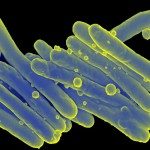Link to Pubmed [PMID] – 24245757
Curr. Pharm. Des. 2014;20(27):4346-56
The emergence of multi- and extensively-drug resistant strains of Mycobacterium tuberculosis makes the development of novel anti-tubercular compounds and the identification of alternative mycobacterial drugable targets urgent priorities. Recently, type VII secretion systems (T7SS) have been discovered in mycobacteria. The genome of M. tuberculosis encodes 5 of such systems (ESX-1 to -5), three of which have been characterized and shown to be essential for viability (ESX-3, ESX-5) or virulence (ESX-1, ESX-5). Because of their crucial role in host-pathogen interactions as well as their involvement in basic biological processes of tubercle bacilli, T7SS/ESX represent promising targets for novel anti-tuberculosis drugs. Here, we review the current knowledge of the T7SS/ESX and their impact on M. tuberculosis physiology and virulence. Finally, we discuss the possible approaches to develop T7SS/ESX inhibitors.

